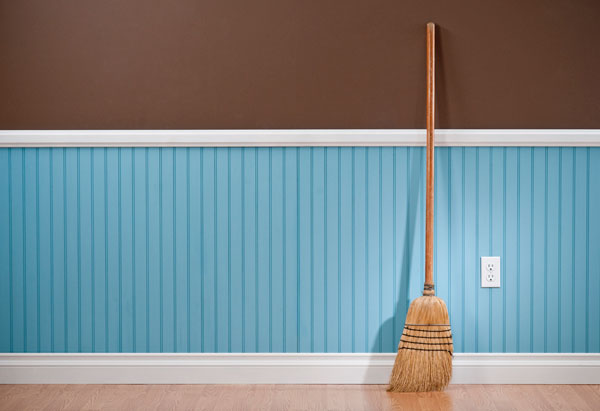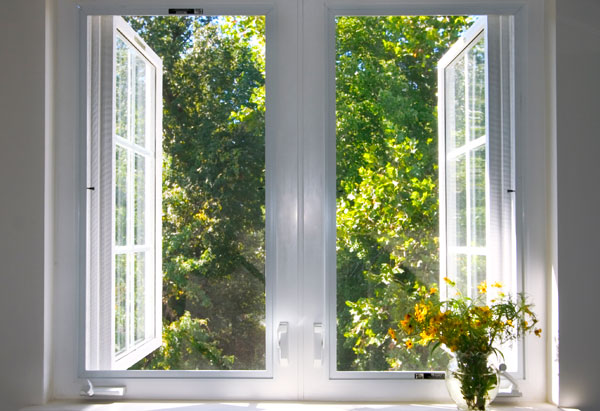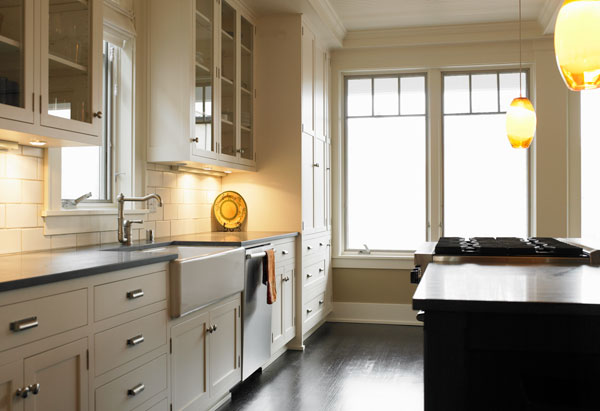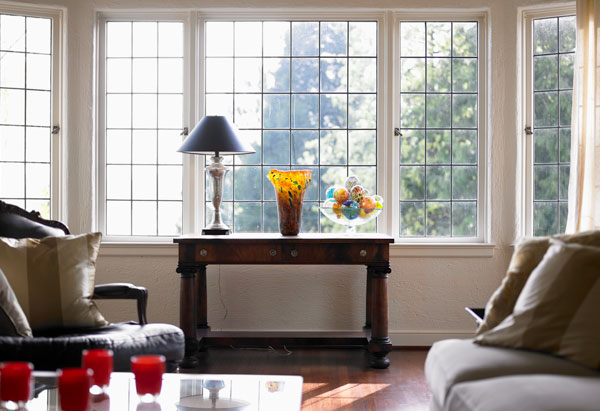Spring-Cleaning That Won't Take Over Your Life: 8 Hours, Start to Finish
Go beyond the weekly dusting, sweeping and mopping to get your home deep-cleaned—all in just one day.

Photo: Thinkstock
9 A.M.–10 A.M.: Bathroom
Vacuum and wipe the walls and ceilings. If you clear them annually of the almost imperceptible grime that builds up, then you won't have to deal with the impossible-to-remove kind that can accumulate if they're left untouched for a few years. Vacuum first, using the brush attachment. Then, wipe them with all-purpose cleaner, which is fine for painted walls. Don't forget the wall that's behind you every morning when you do your hair and makeup; it could be coated in hairspray, perfume or other beauty products.
Toss any throw rugs into the washing machine.
Wash mirrors and the insides of windows. Use microfiber cloths (they won't leave lint).
Spray and soak. Steve Mulloy, director of housekeeping at Hilton Orlando Bonnet Creek, recommends rubbing strong cleaning agents into shower walls, tubs, floors and sinks and then leaving to handle a task in another room. Fifteen or 20 minutes later (you can go move the rugs from the washer to the dryer), come back and rinse everything from the top down, starting with the showerhead. Take the same tack with the toilet, moving from the top of the tank to the rim, bowl and base. And don't use the cloths you used in the bathroom anywhere else before laundering them in very hot water.
Rinse the floor. After you've let the cleanser soak, as mentioned above, wipe the floor with a water-soaked mop on your way out.
Next: Airing out the bedrooms, and the right way to wash all those sheets and dust ruffles

Illustration: Florie Duhau/OWN
Vacuum and wipe the walls and ceilings. If you clear them annually of the almost imperceptible grime that builds up, then you won't have to deal with the impossible-to-remove kind that can accumulate if they're left untouched for a few years. Vacuum first, using the brush attachment. Then, wipe them with all-purpose cleaner, which is fine for painted walls. Don't forget the wall that's behind you every morning when you do your hair and makeup; it could be coated in hairspray, perfume or other beauty products.
Toss any throw rugs into the washing machine.
Wash mirrors and the insides of windows. Use microfiber cloths (they won't leave lint).
Spray and soak. Steve Mulloy, director of housekeeping at Hilton Orlando Bonnet Creek, recommends rubbing strong cleaning agents into shower walls, tubs, floors and sinks and then leaving to handle a task in another room. Fifteen or 20 minutes later (you can go move the rugs from the washer to the dryer), come back and rinse everything from the top down, starting with the showerhead. Take the same tack with the toilet, moving from the top of the tank to the rim, bowl and base. And don't use the cloths you used in the bathroom anywhere else before laundering them in very hot water.
Rinse the floor. After you've let the cleanser soak, as mentioned above, wipe the floor with a water-soaked mop on your way out.
Next: Airing out the bedrooms, and the right way to wash all those sheets and dust ruffles

Illustration: Florie Duhau/OWN

Photo: Thinkstock
10 A.M.–12:30 P.M.: Bedrooms
Vacuum and wipe walls and ceilings, and dust all surfaces. Pay special attention to switch plates and the outside edges of doors, where people tend to grab.
Let it breathe. A good airing will reduce the allergens and germs in mattresses, even if you can't lug them outside. Follow the advice of the Victorian era's go-to guide, Mrs. Beeton's Book of Household Management: "Throw the bed open, by taking off the clothes; open the windows (except in rainy weather), and leave the room to air." In Mrs. Beeton's day, housemaids left the windows open for a half hour, but if it isn't too cold, a few hours is even better.
Head to the washing machine. Once all the linens—sheets, pillowcases, quilts, duvet covers, mattress pads, dust ruffles, shams—are off the beds, wash them in order of what goes on the bed first (i.e., start with dust ruffles and mattress pads; end with shams) so you can put them back on the beds as they come out of the dryer and not have to worry about them sitting in a heap and getting wrinkled. If you're switching over to lighter quilts, wash the winter bedding before putting it away, because moths and other insects are attracted to body oil, perspiration and perfume.
Clean window treatments. For heavy drapes, use the upholstery attachment on your vacuum, or have them dry-cleaned; light drapes can go in the dryer on the fluff cycle with a dryer sheet.
Wash mirrors and the insides of windows.
Shampoo or steam-clean wall-to-wall carpets and area rugs. Some manufacturers will void the warranty if you can't prove that you've had your carpets professionally cleaned every year. Either buy a professional-grade carpet cleaner (which costs around $400) or rent one (many supermarkets now offer this service).
Next: The kitchen (and how to get stubborn grease off of stove grates)

Illustration: Florie Duhau/OWN
Vacuum and wipe walls and ceilings, and dust all surfaces. Pay special attention to switch plates and the outside edges of doors, where people tend to grab.
Let it breathe. A good airing will reduce the allergens and germs in mattresses, even if you can't lug them outside. Follow the advice of the Victorian era's go-to guide, Mrs. Beeton's Book of Household Management: "Throw the bed open, by taking off the clothes; open the windows (except in rainy weather), and leave the room to air." In Mrs. Beeton's day, housemaids left the windows open for a half hour, but if it isn't too cold, a few hours is even better.
Head to the washing machine. Once all the linens—sheets, pillowcases, quilts, duvet covers, mattress pads, dust ruffles, shams—are off the beds, wash them in order of what goes on the bed first (i.e., start with dust ruffles and mattress pads; end with shams) so you can put them back on the beds as they come out of the dryer and not have to worry about them sitting in a heap and getting wrinkled. If you're switching over to lighter quilts, wash the winter bedding before putting it away, because moths and other insects are attracted to body oil, perspiration and perfume.
Clean window treatments. For heavy drapes, use the upholstery attachment on your vacuum, or have them dry-cleaned; light drapes can go in the dryer on the fluff cycle with a dryer sheet.
Wash mirrors and the insides of windows.
Shampoo or steam-clean wall-to-wall carpets and area rugs. Some manufacturers will void the warranty if you can't prove that you've had your carpets professionally cleaned every year. Either buy a professional-grade carpet cleaner (which costs around $400) or rent one (many supermarkets now offer this service).
Next: The kitchen (and how to get stubborn grease off of stove grates)

Illustration: Florie Duhau/OWN

Photo: Thinkstock
12:30 P.M.–2 P.M.: Kitchen
Clean the refrigerator and freezer. Empty the contents, store them in a cooler, turn off the fridge, and let the shelves and drawers come to room temperature before you wash them, since glass and ceramic parts could crack if they come into contact with hot water when they are cold. (You can move to the next task while you're waiting.) Once they've warmed up, wipe with a mixture of 2 tablespoons baking soda and a quart of hot water. Rinse and dry. Go over the door seals with hot water and mild dishwashing liquid, and pluck out crumbs and other debris. Dry them well.
Degrease cooking appliances. Take off stove grates and other removable parts, and scrub them with soapy steel wool pads (if the grease just won't come off, try letting them sit overnight in an airtight bag with a quarter cup of ammonia; the next day, wipe them with a clean cloth). Clean the oven. To get stuck-on food particles off the inside of the microwave, put a microwave-safe bowl of water with some lemon juice inside and heat it to boiling for 2 or 3 minutes. The steam will loosen gunk, and the lemon's acid will help lift grease.
Clean window treatments and wash the insides of windows.
Wash surfaces and cabinets. The tops of cabinets and the fridge may be sticky from grease, so a solution of warm water and dishwashing liquid will work best. You can also use the mixture in drawers and on shelves (and spray antibacterial cleanser inside the cabinet where you store trash). Pay attention to the utensils drawer and the pantry, since they collect the most crumbs.
Sweep, vacuum and mop floors.
Next: The living room—and the trick to safely cleaning your electronics

Illustration: Florie Duhau/OWN
Clean the refrigerator and freezer. Empty the contents, store them in a cooler, turn off the fridge, and let the shelves and drawers come to room temperature before you wash them, since glass and ceramic parts could crack if they come into contact with hot water when they are cold. (You can move to the next task while you're waiting.) Once they've warmed up, wipe with a mixture of 2 tablespoons baking soda and a quart of hot water. Rinse and dry. Go over the door seals with hot water and mild dishwashing liquid, and pluck out crumbs and other debris. Dry them well.
Degrease cooking appliances. Take off stove grates and other removable parts, and scrub them with soapy steel wool pads (if the grease just won't come off, try letting them sit overnight in an airtight bag with a quarter cup of ammonia; the next day, wipe them with a clean cloth). Clean the oven. To get stuck-on food particles off the inside of the microwave, put a microwave-safe bowl of water with some lemon juice inside and heat it to boiling for 2 or 3 minutes. The steam will loosen gunk, and the lemon's acid will help lift grease.
Clean window treatments and wash the insides of windows.
Wash surfaces and cabinets. The tops of cabinets and the fridge may be sticky from grease, so a solution of warm water and dishwashing liquid will work best. You can also use the mixture in drawers and on shelves (and spray antibacterial cleanser inside the cabinet where you store trash). Pay attention to the utensils drawer and the pantry, since they collect the most crumbs.
Sweep, vacuum and mop floors.
Next: The living room—and the trick to safely cleaning your electronics

Illustration: Florie Duhau/OWN

Photo: Thinkstock
2 P.M.–5 P.M.: Living Room, Family Room and Dining Room
Dust ceiling fans. Donna Smallin, author of The One-Minute Cleaner, prefers an extendable duster with a microfiber head that bends to a 90-degree angle so she doesn't have to get on a ladder. It's also useful for the tops of bookcases and shelves.
Vacuum and wipe walls and ceilings.
Care for your couch. Sofas and upholstered chairs get tons of use. Yet, says Sim Fern, co-founder of Mod Restoration, a furniture-repair shop in Brooklyn, some people never clean them. Just because you don't see stains doesn't mean there aren't dust mites present (they feed on skin flakes shed by humans and animal dander). Many Lowe's and Home Depot stores rent upholstery-cleaning machines or carpet-cleaning machines with upholstery wands, which will give your sofa and chairs a deep clean.
Wash your lightbulbs. Give them a wipe with a damp microfiber cloth, since a dirty bulb emits 20 percent less light.
Clean window treatments and wash the insides of windows.
Clean and dust electronics. Spray compressed air into crevices. Then, moving from top to bottom, use microfiber or electrostatic cloths. Clean underneath speakers, stereos, computers, DVD players and TVs too. Wipe away from ventilation areas so you don't push dust back in.
Sweep out your fireplace, storing unused logs.
Clean the carpets.
Order pizza for dinner.
More Home Advice

Illustration: Florie Duhau/OWN
Dust ceiling fans. Donna Smallin, author of The One-Minute Cleaner, prefers an extendable duster with a microfiber head that bends to a 90-degree angle so she doesn't have to get on a ladder. It's also useful for the tops of bookcases and shelves.
Vacuum and wipe walls and ceilings.
Care for your couch. Sofas and upholstered chairs get tons of use. Yet, says Sim Fern, co-founder of Mod Restoration, a furniture-repair shop in Brooklyn, some people never clean them. Just because you don't see stains doesn't mean there aren't dust mites present (they feed on skin flakes shed by humans and animal dander). Many Lowe's and Home Depot stores rent upholstery-cleaning machines or carpet-cleaning machines with upholstery wands, which will give your sofa and chairs a deep clean.
Wash your lightbulbs. Give them a wipe with a damp microfiber cloth, since a dirty bulb emits 20 percent less light.
Clean window treatments and wash the insides of windows.
Clean and dust electronics. Spray compressed air into crevices. Then, moving from top to bottom, use microfiber or electrostatic cloths. Clean underneath speakers, stereos, computers, DVD players and TVs too. Wipe away from ventilation areas so you don't push dust back in.
Sweep out your fireplace, storing unused logs.
Clean the carpets.
Order pizza for dinner.
More Home Advice
- There's a wrong way to dust?
- Cleaning the impossible: Smart ways to remove decades-old dirt
- How to declutter your home—for good

Illustration: Florie Duhau/OWN



